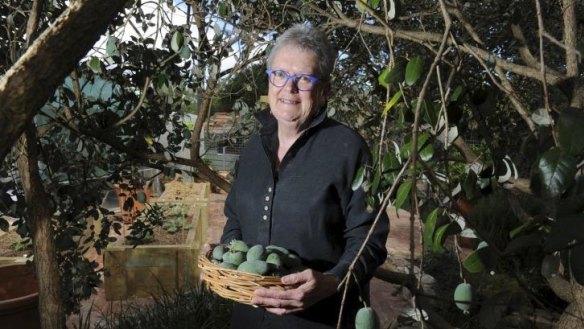Landscape expert creates her ideal garden

Landscape architect Barbara Payne likes to design biodiverse, resilient and productive gardens that are aesthetically pleasing places to be in and look out upon.
residential work in Canberra, Bungendore and Bywong, in 2010 Payne was asked to prepare a master plan for an understorey in the Southern Tablelands Ecosystems Park at the National Arboretum Canberra. She chose a mosaic of plants that reflect their location under the natural landscape of eucalypts.
Payne says the name of her practice, Quandong Designs, comes from her early childhood at Nukarni in the eastern wheatbelt of Western Australia. When picnicking in the bush, her favourite location was a granite outcrop, which around 1901 was a sandalwood cutters' camp.
The quandong (Santalum acuminatum) is a member of the sandalwood family and, as children, her family had a set of Chinese chequers made using painted quandong nuts.
From 2002, for three years, Payne and her partner Garry Grant lived in Brussels, where he worked, and she made day trips to London to attend short courses in garden design. Back in Canberra, she resigned from her job at the Australian National University and enrolled in landscape architecture at the University of Canberra, also studying vegetation ecology and Australian landforms and soils.
At home in O'Connor, Payne has designed a new back garden, built by landscaper Grant Waser, to make raised vegetable beds which are possum-proof and age-friendly. They have recently been planted with Russian kale, artichokes, rhubarb , broccoli, mixed oakleaf and mignonette lettuces and one bed, made from the old timber back steps, is dedicated to asparagus.
A William pear tree, which was in the garden when the couple bought the house in 1991, has now been espaliered, one of two feijoa trees has had lower foliage removed to show its shapely branches and hanging fruit, and male and female Haywood kiwi fruit trees cover a pergola and are laden with fruit. There are two fig trees, a Brown Turkey and a White Genoa.
Handsome large terracotta pots are planted with citrus – a Chinotto, which makes good marmalade, a blood orange, a makrut lime and three Australian Red Centre limes.
There are young plantings of a trio of European plums – greengage, purple gage and Coe's Golden Drop, a Morello cherry, a double grafted Japanese plum – satsuma and Santa Rosa. A large Washington navel near the back deck keeps the household in oranges for six weeks in winter.
They have been members of Canberra Organic Growers Society since 2013 and they have a half-plot in the O'Connor community garden. Each year in late July, Payne raises vegetables from seed in a glasshouse in the home garden, including tomato varieties, lettuces and beetroot.
Grant and Payne and Barbara share the cooking. She has a recipe chair beside the bookshelf, so she can read about similar recipes in several books before deciding how she will cook the ingredients – and her feijoa jelly recipe below is a composite of a couple of recipes.
Her favourite authors are Elizabeth David, Marcella Hazan, Claudia Roden, Stephanie Alexander, Julie Sahni and Yotam Ottolenghi. Then there is her mother's 1940-50s Country Women's Association Cookbook, no cover, pages missing, from which she makes a magnificent plum sauce. One of the ingredients is fresh ginger, surprising for 70 years ago in the WA bush.
CWA PLUM SAUCE
2.5kg dark plums
1.25kg sugar
2 dessertspoons salt
half tsp cinnamon
15g cloves
1.5 litres vinegar
15g whole pepper
½ tsp cayenne pepper
120g fresh ginger
½ tsp allspice
Bruise ginger and boil all slowly together until the stones leave the fruit, then strain through a colander and bottle in warm, dry, sterilised bottles.
BARBARA'S FEIJOA JELLY
3kg feijoas
sugar
1 lemon
When feijoas start falling, collect three kilograms. Wash fruit and cut up roughly (no need to peel). Do not use damaged fruit. Put into a preserving pan with enough water to just cover. Cook gently for 45 minutes until fruit is pulpy and broken down. Strain through a jelly bag overnight. Do not squeeze the jelly bag. Measure the strained juice and put into a preserving pan, add the juice of a lemon, bring to the boil and add sugar (about 600g per litre of juice). Boil briskly until setting point is reached, and then pour into clean, hot, dry jars and seal.
Susan Parsons is a Canberra writer